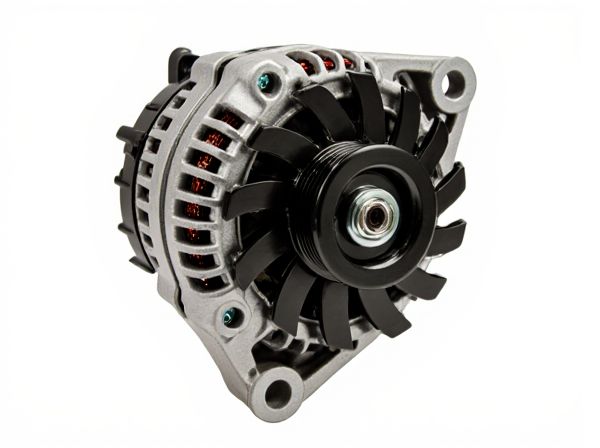
Photo illustration: External Fan Cooled vs Internal Fan Cooled
External fan cooled devices dissipate heat by using a fan mounted outside the enclosure, enhancing airflow around the equipment for effective temperature control. Internal fan cooled systems rely on fans inside the enclosure to circulate air directly over components, maintaining optimal operating conditions within compact spaces. Choosing between these cooling methods depends on your device's design constraints and environmental cooling requirements.
Table of Comparison
| Feature | External Fan Cooled Alternator | Internal Fan Cooled Alternator |
|---|---|---|
| Cooling Mechanism | External fan mounted outside alternator housing | Fan integrated inside alternator housing |
| Heat Dissipation | Direct air flow over housing for effective cooling | Air circulates inside housing, cooling internal components |
| Durability | Prone to damage due to exposure | Protected fan, higher durability in harsh environments |
| Maintenance | Easier fan access, simpler cleaning and replacement | More complex due to enclosed fan design |
| Noise Level | Generally noisier due to exposed fan blades | Quieter operation because fan is enclosed |
| Application | Common in older vehicle models and high airflow needs | Used in modern vehicles prioritizing compact design |
Introduction to Fan Cooling Systems
External fan cooled systems position the fan outside the device, allowing direct airflow to dissipate heat effectively, often improving reliability by minimizing internal component exposure to dust and debris. Internal fan cooled systems house the fan within the device, promoting targeted cooling of specific internal components, which can enhance heat dissipation in compact or sealed environments. Selecting between external and internal fan cooling depends on factors like device design, environmental conditions, and thermal management requirements.
What is External Fan Cooling?
External fan cooling refers to a system where the cooling fan is mounted outside the device or enclosure, facilitating direct airflow over heat sinks or components to dissipate heat effectively. This method enhances thermal management by allowing cooler ambient air to enter and hot air to exit without circulating within the device, reducing the risk of internal dust accumulation and overheating. External fan cooled designs are commonly used in industrial equipment, computer cases, and power supplies to maintain optimal operating temperatures and improve component lifespan.
What is Internal Fan Cooling?
Internal fan cooling involves the use of a fan located inside the device or equipment to circulate air directly over internal components, such as processors or power supplies, to dissipate heat efficiently. This method enhances thermal management by maintaining consistent airflow within the enclosure, preventing overheating and ensuring optimal performance. Internal fan cooling is commonly found in electronics, industrial machinery, and computer hardware where space constraints and targeted cooling are critical.
Key Differences Between External and Internal Fan Cooling
External fan cooled systems feature fans mounted outside the device, providing superior airflow and heat dissipation by drawing cooler ambient air directly across heat sinks. Internal fan cooled systems have fans inside the enclosure, circulating air within the device to prevent overheating but often resulting in higher internal temperatures due to limited airflow exchange with the environment. External fan cooling typically offers better thermal management and longer equipment lifespan compared to internal fan cooling, which is more compact but may require frequent maintenance to avoid dust buildup and overheating.
Advantages of External Fan Cooled Systems
External fan cooled systems offer superior heat dissipation by positioning the fan outside the enclosure, reducing internal dust accumulation and enhancing overall equipment longevity. These systems provide improved airflow management, leading to lower operating temperatures and increased energy efficiency. Maintenance is simplified due to easier access to the fan, minimizing downtime compared to internal fan cooled setups.
Benefits of Internal Fan Cooled Systems
Internal fan-cooled systems provide enhanced thermal management by directly dissipating heat from critical components, leading to improved device reliability and longevity. They offer quieter operation compared to external fan-cooled units since the fans are enclosed within the device, reducing noise pollution in sensitive environments. Additionally, internal fan cooling minimizes dust and debris infiltration, maintaining cleaner internal circuitry and lowering maintenance costs.
Limitations and Drawbacks: External vs Internal Cooling
External fan-cooled systems often face challenges such as increased exposure to dust, dirt, and environmental debris, which can compromise cooling efficiency and increase maintenance requirements. Internal fan-cooled systems, while protected from external contaminants, are limited by confined space for airflow, potentially leading to overheating under high loads or inadequate ventilation. Both methods can suffer from noise issues, but internal fans may also struggle with heat dissipation due to proximity to internal components.
Performance Comparison: Efficiency and Reliability
External fan cooled systems typically offer higher efficiency by providing better airflow and heat dissipation, reducing the risk of overheating and improving overall device lifespan. Internal fan cooled units often suffer from restricted airflow due to compact housing, which can result in higher operating temperatures and increased wear on components. Reliability tends to be greater in external fan cooled solutions as the fans operate in less constrained environments, minimizing dust accumulation and mechanical stress.
Ideal Applications for Each Cooling Method
External fan cooled systems excel in applications requiring high airflow and dust protection, commonly found in industrial environments like manufacturing plants and outdoor electrical enclosures. Internal fan cooled units are ideal for compact spaces with limited ventilation, such as data centers and telecommunications cabinets, where maintaining internal air circulation prevents overheating without external contaminants. Selecting the right cooling method depends on the operational environment and the level of contamination control needed for optimal equipment performance.
Choosing the Right Cooling Solution for Your Needs
External fan cooled systems offer superior heat dissipation by positioning the fan outside the enclosure, ideal for environments with restricted internal airflow or higher ambient temperatures. Internal fan cooled units integrate the fan within the device housing, providing efficient localized cooling suited for compact spaces and controlled conditions. Selecting the right cooling solution depends on factors such as equipment size, ambient temperature, dust exposure, and maintenance accessibility to ensure optimal thermal management and device longevity.
 caratoz.com
caratoz.com